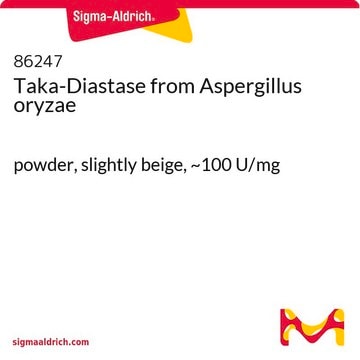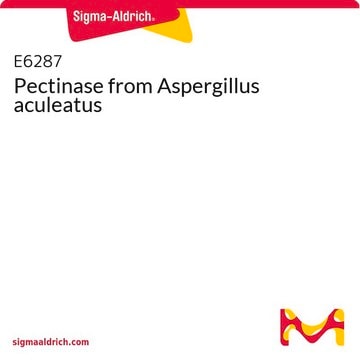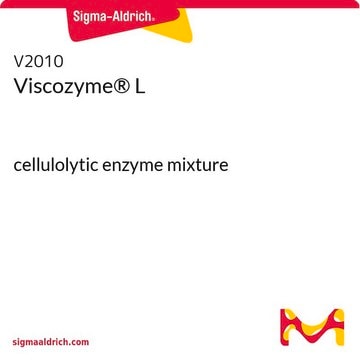42395
Tannase from Aspergillus ficuum
powder, white, ≥150 U/g
Synonym(s):
Tannin acyl Hydrolase
Sign Into View Organizational & Contract Pricing
All Photos(1)
About This Item
Recommended Products
biological source
Aspergillus sp. (A. ficuum)
form
powder
specific activity
≥150 U/g
impurities
25 mM potassium phosphate
250 mM NaCl
50% glycerol
color
white
storage temp.
2-8°C
Related Categories
General description
Tannase is an enzyme that is produced by several organisms such as plants, bacteria, fungi, and yeast. This enzyme is also found in plant sources such as tannin-rich vegetables, especially in the leaves, fruits, branches, and bark.
Application
Tannase from Aspergillus ficuum has been used:
- as a standard to determine the tannase activity of bacterial isolates
- to study its effects on the inhibitory activity of tannic acid on biofilm formation
- to obtain Proanthocyanidins (PA) by enzymatic hydrolysis of grape skin and seeds
Biochem/physiol Actions
Tannase catalyzes the ester bonds located in complex tannins, gallo-tannins, and gallic acid esters, which results in the release of gallic acid. This enzyme can be used as a clarifying agent in the manufacture of beer, tea, wine, and juices and to treat tannin-polluting agricultural waste and industrial effluents.
Unit Definition
1 U corresponds to the amount of enzyme which changes the absorbance at 310 nm by 1.0 per minute at pH 4.7 and 30°C (tannic acid as substrate, final volume 3 ml)
Signal Word
Danger
Hazard Statements
Precautionary Statements
Hazard Classifications
Resp. Sens. 1
Storage Class Code
11 - Combustible Solids
WGK
WGK 1
Flash Point(F)
Not applicable
Flash Point(C)
Not applicable
Personal Protective Equipment
dust mask type N95 (US), Eyeshields, Gloves
Certificates of Analysis (COA)
Search for Certificates of Analysis (COA) by entering the products Lot/Batch Number. Lot and Batch Numbers can be found on a product’s label following the words ‘Lot’ or ‘Batch’.
Already Own This Product?
Find documentation for the products that you have recently purchased in the Document Library.
Customers Also Viewed
Amrita Banerjee et al.
The protein journal, 31(4), 306-327 (2012-03-31)
The tannase protein sequences of 149 bacteria and 36 fungi were retrieved from NCBI database. Among them only 77 bacterial and 31 fungal tannase sequences were taken which have different amino acid compositions. These sequences were analysed for different physical
Optimization of gallic acid production from Terminalia chebula by Aspergillus niger
N. Lokeswari, K. Jaya Raju
E-Journal of Chemistry, 4, 287-293 (2007)
Chandini S Kumar et al.
Critical reviews in food science and nutrition, 53(2), 180-197 (2012-10-18)
Ready-to-drink (RTD) tea is a popular beverage in many countries. Instability due to development of haze and formation of tea cream is the common problem faced in the production of RTD black tea beverages. Thus decreaming is an important step
Prasanna D Belur et al.
Journal of microbiology and biotechnology, 22(2), 199-206 (2012-03-01)
Naturally immobilized tannase (tannin acyl hydrolase, E.C. 3.1.1.20) has many advantages, as it avoids the expensive and laborious operation of isolation, purification, and immobilization, plus it is highly stable in adverse pH and temperature. However, in the case of cell-associated
S P Beena et al.
Natural product communications, 6(12), 1933-1938 (2012-02-09)
Garcinia gummi-gutta (syn. G. cambogia, G. quaesita), known to have medicinal properties, was evaluated as a substrate and inducer for tannase production by a marine Aspergillus awamori BTMFW032, under slurry state fermentation using Czapekdox-minimal medium and sea water as the
Our team of scientists has experience in all areas of research including Life Science, Material Science, Chemical Synthesis, Chromatography, Analytical and many others.
Contact Technical Service











